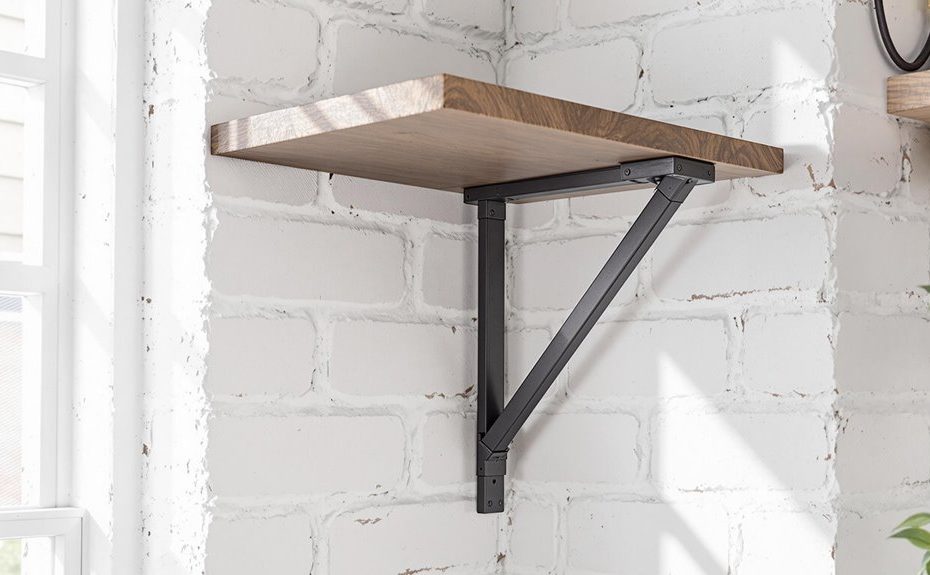Looking to add some personality to your walls? DIY shelf brackets offer endless creative possibilities for your home. From industrial pipe brackets that give an urban edge to rustic rope-and-wood combinations perfect for coastal vibes, you'll find options for every style. Try minimalist wooden triangles for a modern touch, or explore vintage door hinges for classic charm. Leather straps and macramé hangers bring texture, while concrete blocks offer contemporary flair on a budget. Whether you're into metallic brass rods or salvaged barn wood, these unique bracket ideas will transform your shelving from basic to brilliant. Let's explore these inspiring options to elevate your space.
Industrial Pipe Shelf Brackets
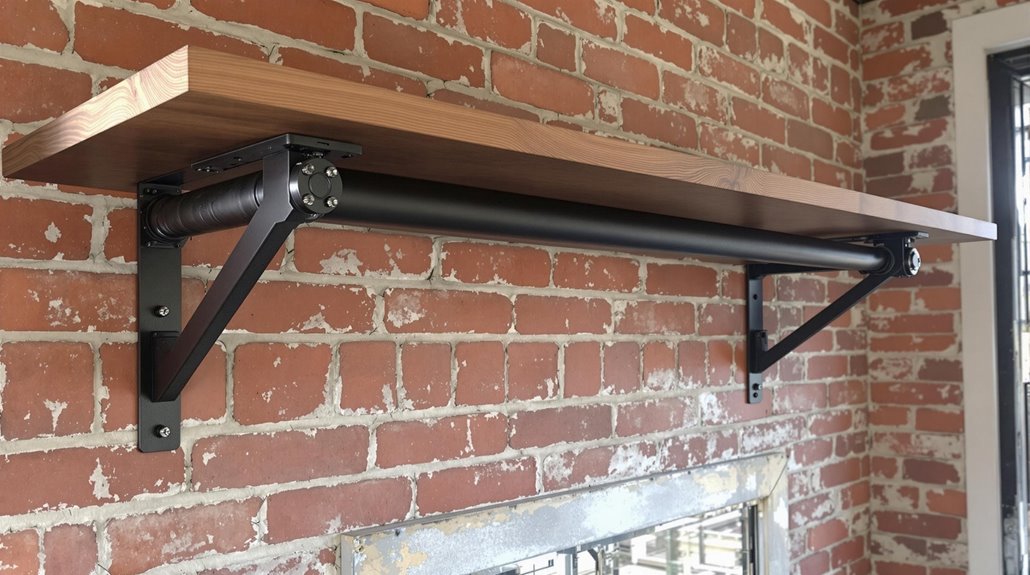
Industrial pipe shelf brackets offer a perfect blend of functionality and urban aesthetics, combining raw industrial materials with modern design sensibilities. Following current industrial design trends, these brackets are easy to customize using basic pipe fitting techniques. You can create stunning shelving solutions by connecting various pipe pieces and fittings, giving your space that coveted industrial-chic look you've been dreaming of.
Minimalist Wood Triangle Brackets
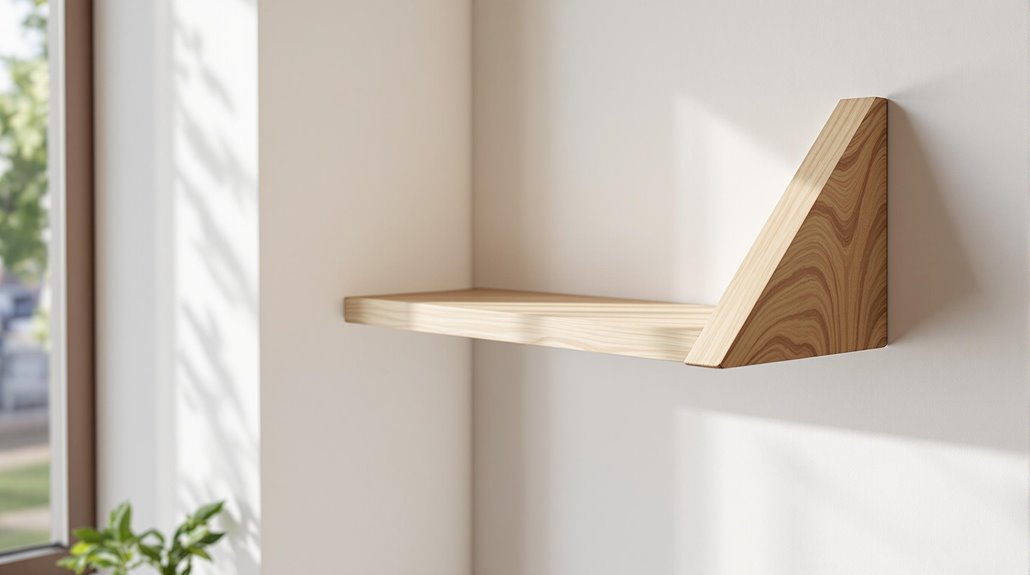
Craftsmen and DIY enthusiasts alike appreciate the clean, geometric appeal of minimalist wood triangle brackets. These simple yet striking supports blend seamlessly with modern wooden aesthetics while providing reliable storage solutions. You can create them using basic 45-degree cuts, and their minimalist design works beautifully in any room. Paint them to match your decor or leave them natural for authentic charm.
Rope and Wood Brackets
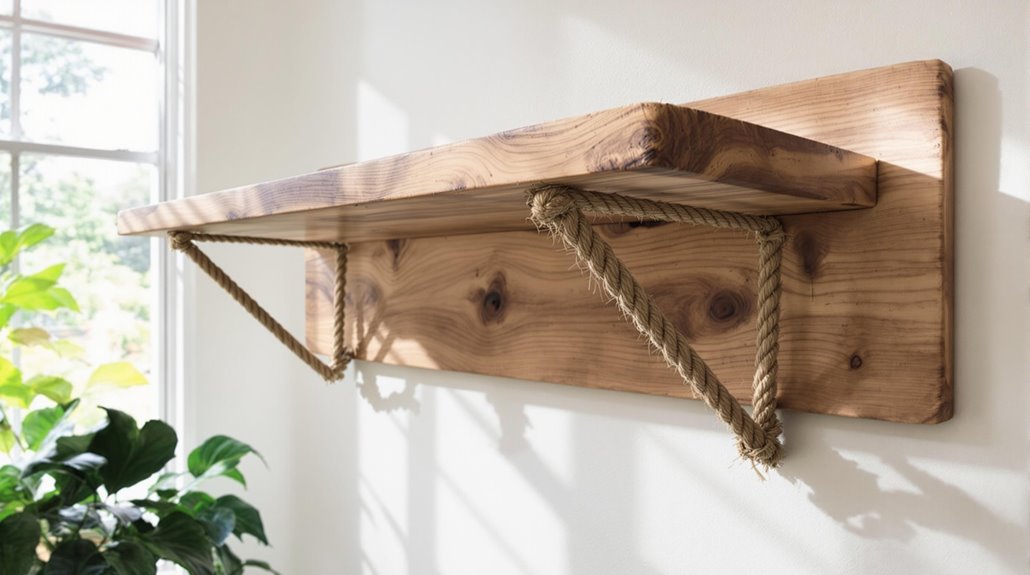
Combining the rustic appeal of natural rope with sturdy wooden planks creates a unique and versatile shelf bracket solution. The rope weaving technique adds strength while bringing a touch of nautical decor to your space. You'll love how easily these brackets complement both coastal and farmhouse styles. Simply wrap thick rope around wooden posts and secure them tightly for a charming, functional support system.
Vintage Door Hinge Brackets
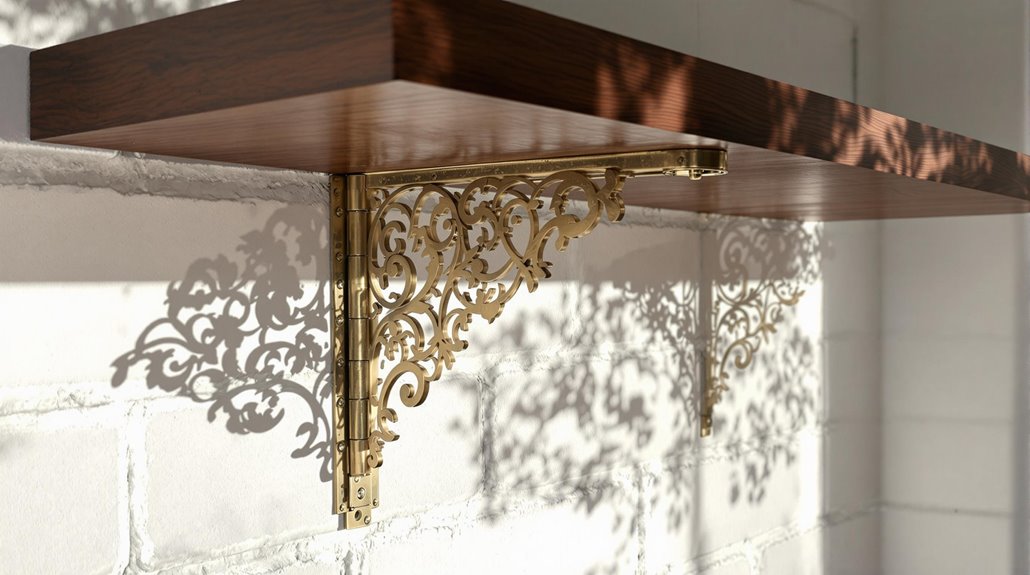
Old door hinges can find new life as distinctive shelf brackets, offering both architectural character and sturdy support. You can easily transform salvaged door hardware into unique brackets that enhance your home's vintage aesthetics. Simply clean the hinges, paint or distress them to match your decor, and mount them securely to the wall. Your shelves will showcase history while providing practical storage.
Leather Strap Shelf Supports
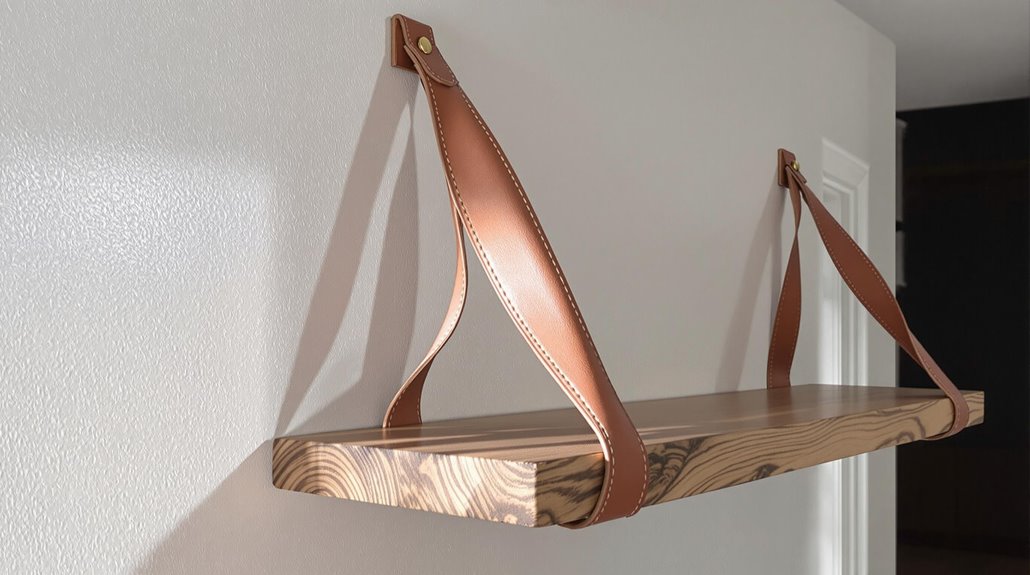
For a minimalist and organic approach to shelf support, leather straps offer an elegant solution that marries form with function. You'll want to choose thick, full-grain leather types for durability and a polished look. When it comes to installation tips, pre-drill your holes carefully and use washers behind the leather to prevent tearing. Your shelves will look stunning with these rustic yet refined supports.
Metal Bar Geometric Brackets
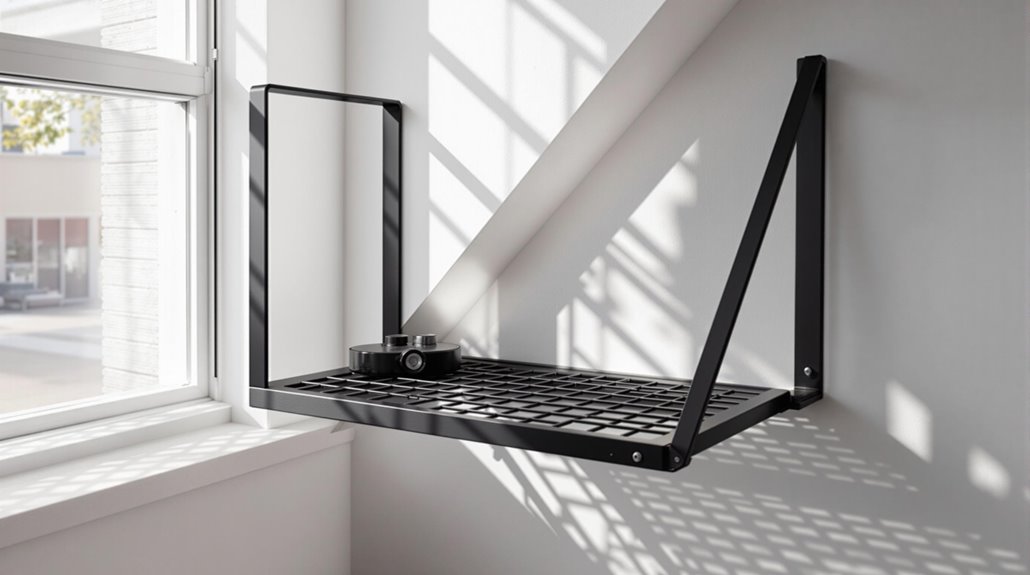
While leather brings natural warmth to shelf supports, metal bar geometric brackets offer industrial sophistication and striking visual appeal. You can create eye-catching patterns using metal bar aesthetics and basic geometric design principles. Try combining straight bars at various angles to form triangles, diamonds, or zigzag patterns that not only support your shelves but also serve as modern wall art.
Copper Pipe Corner Brackets
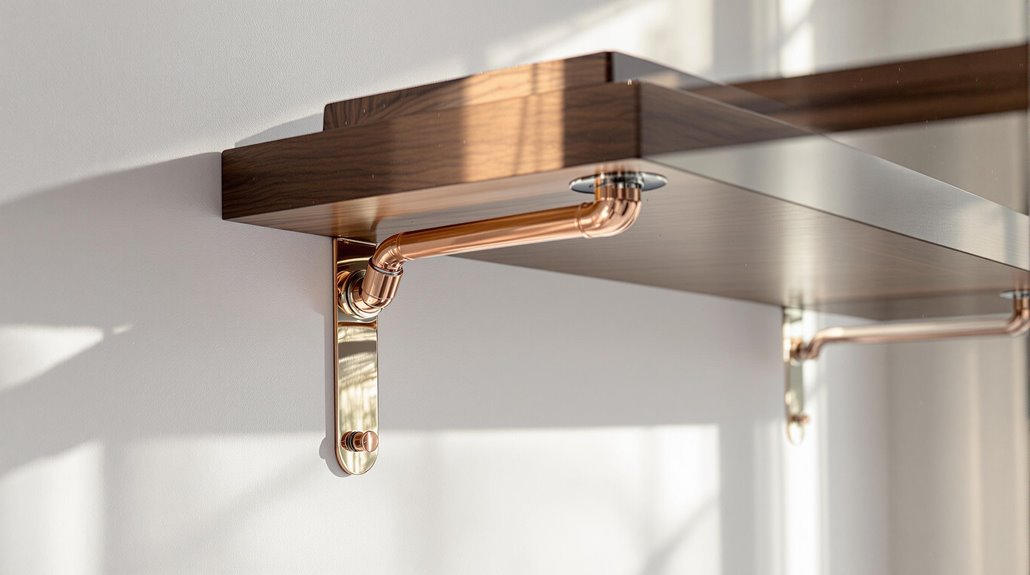
Copper pipe's warm metallic glow makes it an attractive material for creating distinctive corner shelf brackets. If you're into copper pipe projects, you'll love how these brackets add an industrial decor touch to any room. Simply cut copper pipes at 90-degree angles, connect them with elbows, and secure them to your wall. The result is both functional and eye-catching.
Reclaimed Pallet Wood Brackets
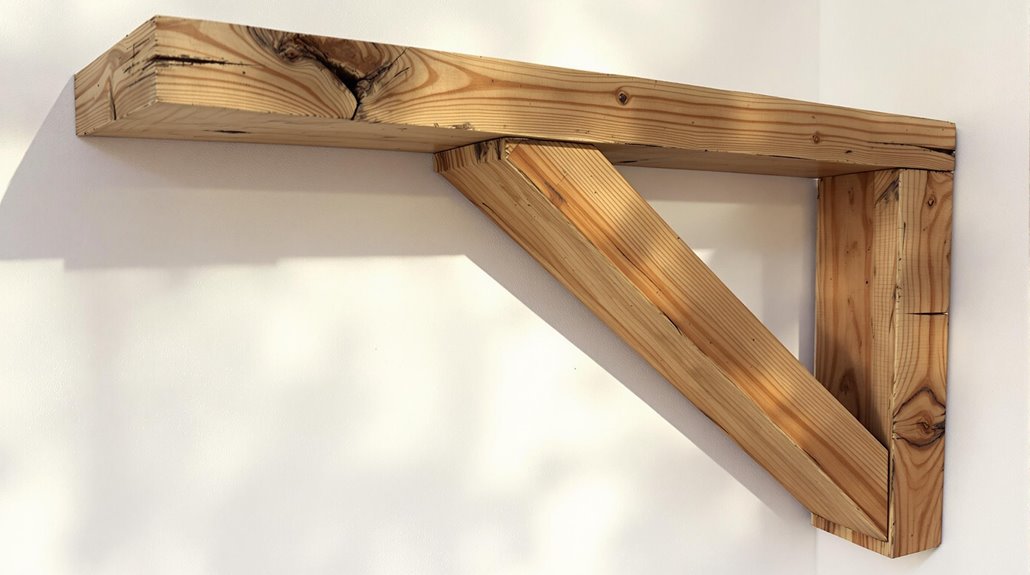
Rustic charm meets sustainability when you transform reclaimed pallet wood into sturdy shelf brackets. With just a few basic tools, you can create these eye-catching supports that add character to any room. Simply cut your pallet wood to size, sand down rough edges, and experiment with different reclaimed wood finishes. These pallet wood projects are perfect for both beginners and experienced DIYers.
Branch and Twig Supports
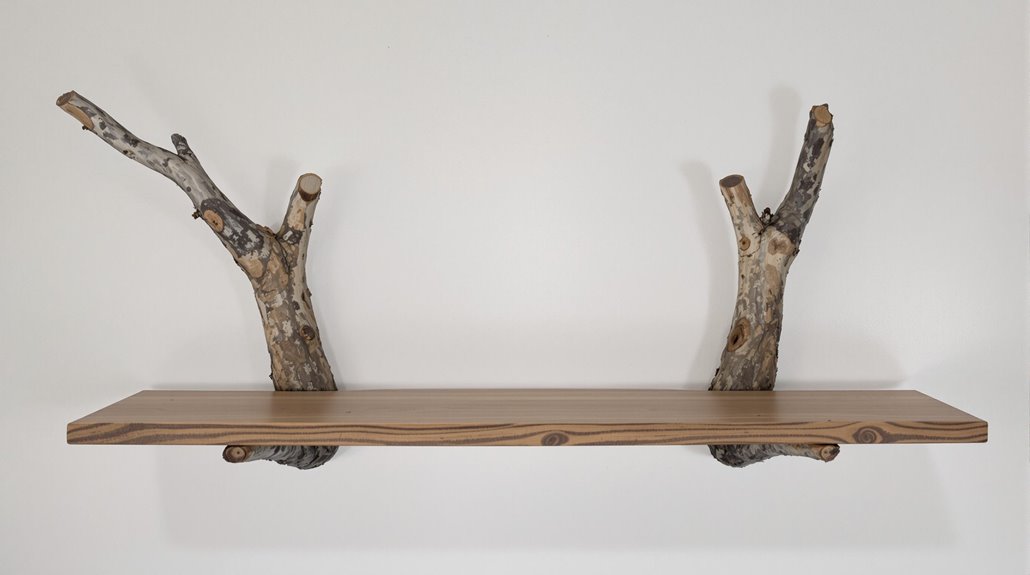
Natural branch and twig supports offer an organic alternative to traditional shelf brackets, bringing the outdoors inside with their unique, forest-inspired aesthetic. You can easily create these charming supports by selecting sturdy Y-shaped branches and treating them with a natural sealant. Their rustic charm works perfectly in cabins, cottages, or any space where you want to showcase nature's natural aesthetics.
Steel Cable Suspension Brackets
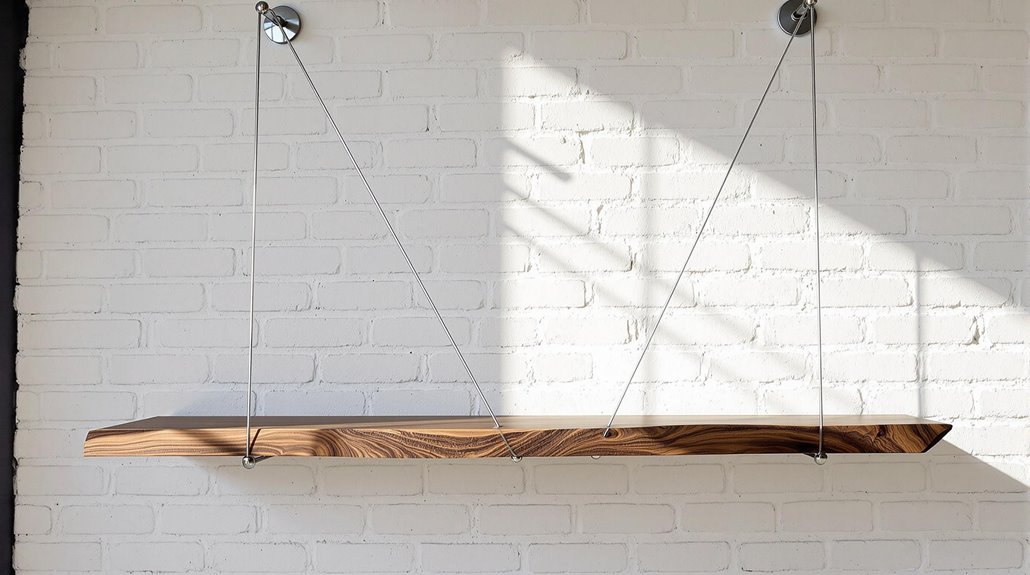
Steel cable suspension brackets offer a sleek, industrial alternative to traditional shelf supports, combining minimalist design with remarkable strength. You'll need proper cable tension to guarantee your shelves remain level and secure. When installing these brackets, always check your wall stability first. The cables create an eye-catching floating effect that makes your shelves appear to defy gravity.
Cast Iron Bracket Design
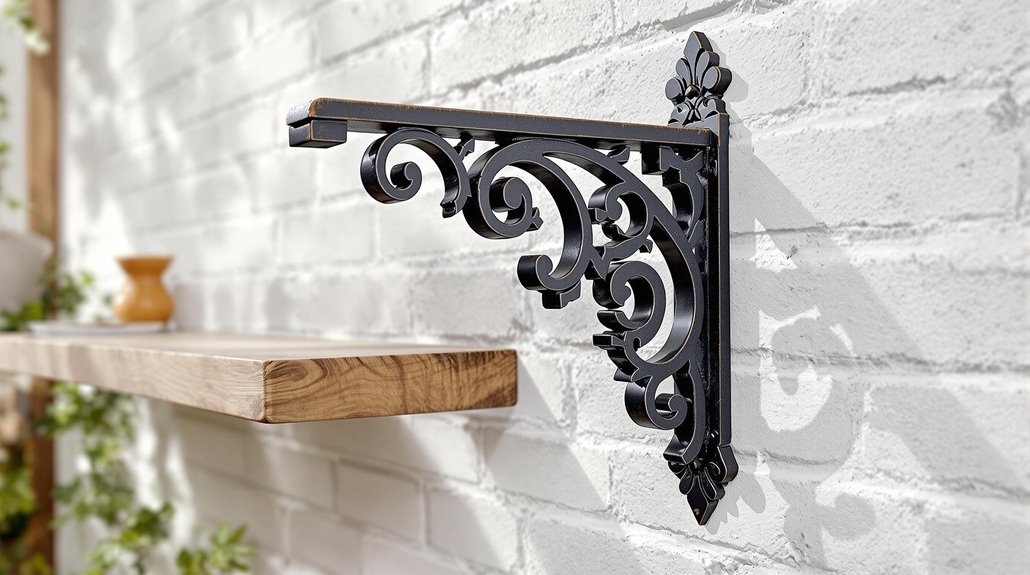
Ornate and timeless, cast iron brackets bring classic Victorian-era elegance to any shelf installation. These vintage cast pieces showcase intricate scrollwork and floral patterns that you'll love displaying in your home. For a truly authentic look, search flea markets for decorative cast brackets from the 1800s, or choose from modern reproductions that capture the same beautiful detail and sturdy construction.
Distressed Metal L-Brackets
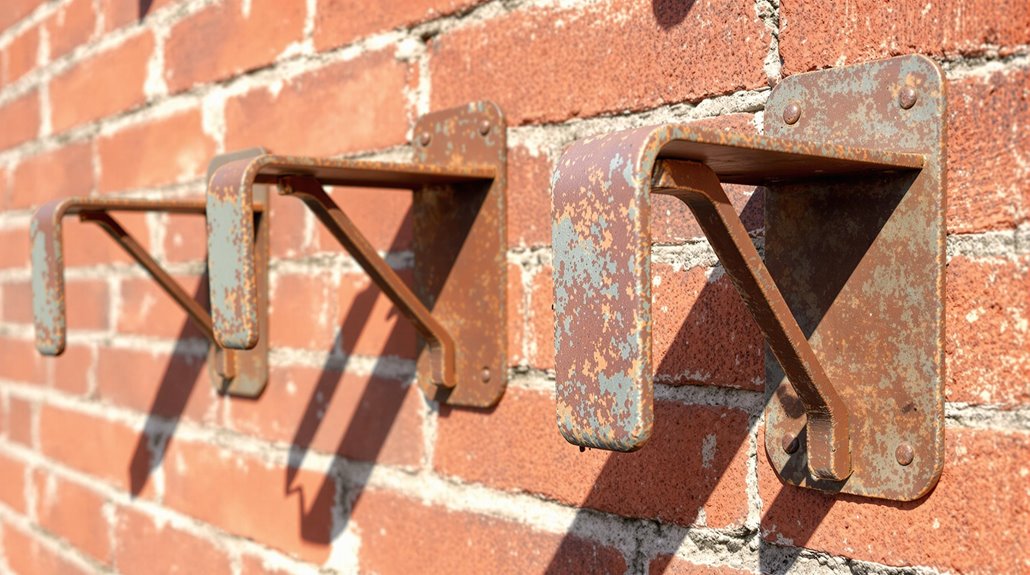
While cast iron brackets celebrate ornate Victorian design, distressed metal L-brackets embrace industrial minimalism with their raw, weathered appeal. You'll love how these rustic decor elements add vintage charm to any space. Simply sand down basic metal L-brackets and treat them with vinegar or oxidizing solutions to achieve that perfectly aged patina. They're especially striking when paired with reclaimed wood shelving.
Macramé Shelf Hangers
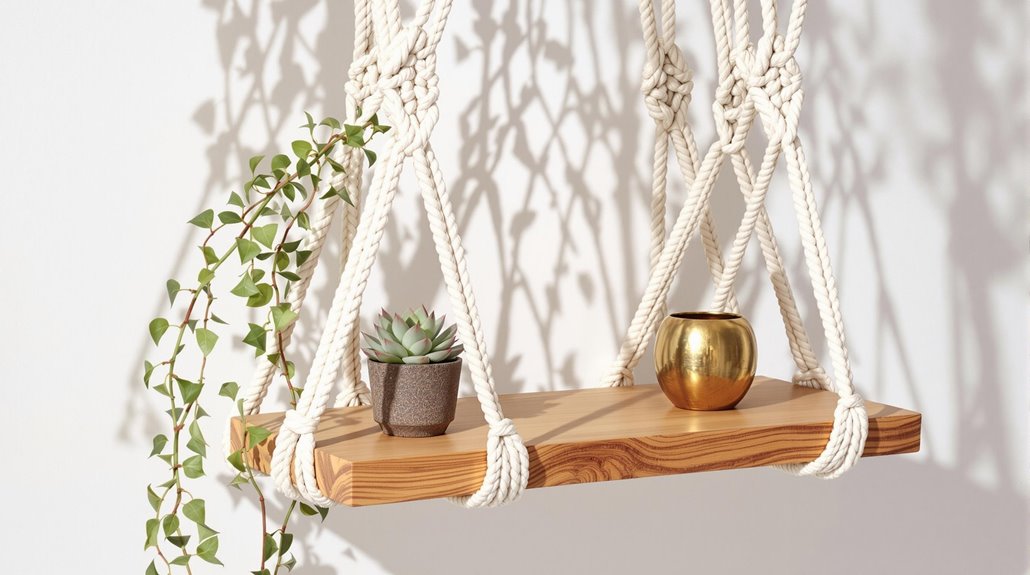
Crafted from intricately knotted cotton cord, macramé shelf hangers offer a bohemian alternative to traditional bracket systems. You can create colorful macramé designs that double as stunning macramé wall art while supporting your shelves. The beauty of these hangers lies in their versatility – choose natural white for a subtle look, or experiment with dyed cords to match your room's palette.
Salvaged Barn Wood Brackets
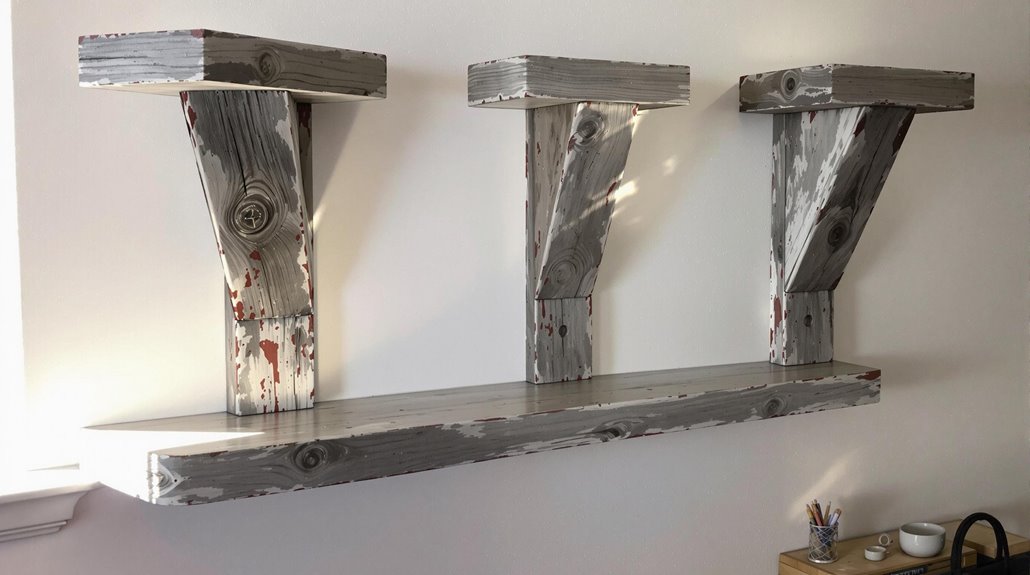
Rustic salvaged barn wood brackets bring timeless character to any shelf installation. You can create unique supports by cleaning and repurposing weathered wood from old barns. The barn wood restoration process is simple – just sand lightly to preserve the patina while removing splinters. These brackets perfectly complement rustic decor and can support substantial weight when properly mounted.
Concrete Block Shelf Supports
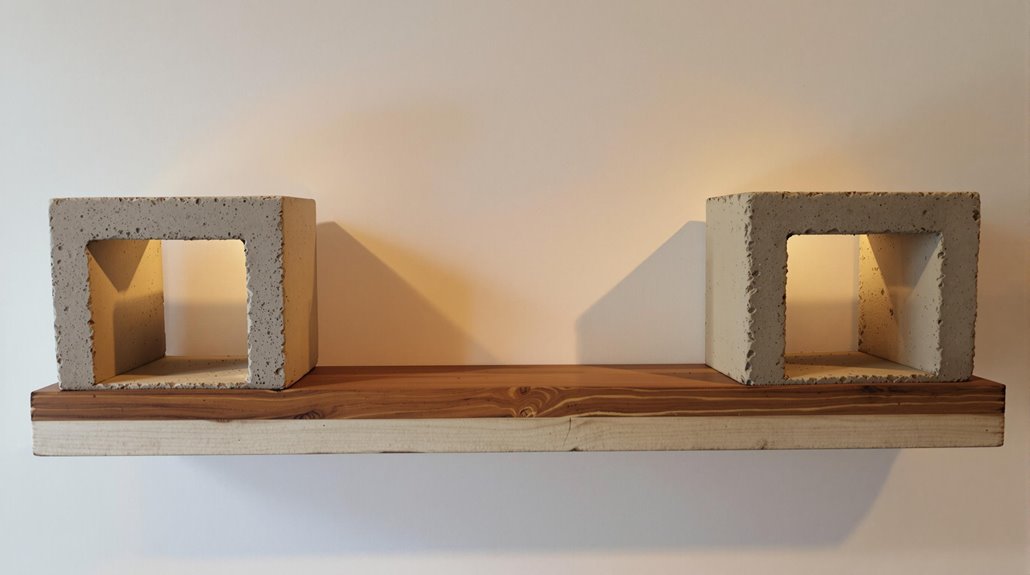
Modern and industrial-style shelf supports can be created using simple concrete blocks, offering both functionality and contemporary appeal. You can experiment with various concrete finishes, from smooth to textured, to match your decor. Stack different block designs to create unique configurations, or paint them for added personality. This budget-friendly solution works especially well in urban lofts and minimalist spaces.
Brass Rod Hanging Brackets
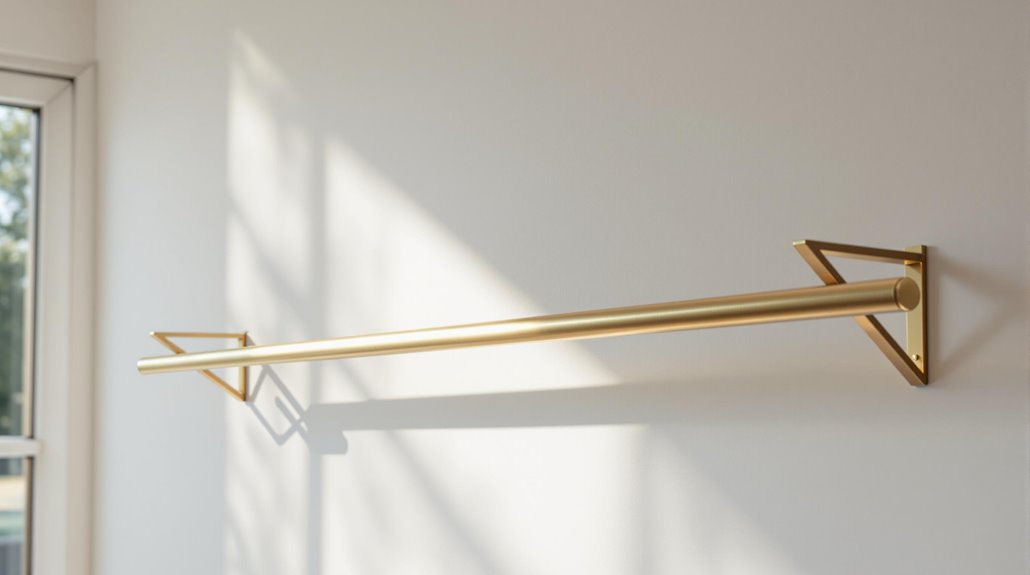
Elegant and versatile, brass rod hanging brackets add a touch of sophistication to any shelf installation. You can find these brackets in various brass rod designs, from minimalist straight lines to decorative curves. The warm glow of different brass rod finishes, whether polished or brushed, creates an inviting atmosphere while providing reliable support for your shelving needs.
Frequently Asked Questions
How Much Weight Can DIY Shelf Brackets Typically Support Safely?
The weight capacity of DIY shelf brackets varies considerably based on material considerations and construction methods. Properly built wooden brackets typically support 50-75 pounds per bracket, while metal versions can hold 100-200 pounds. For your safety, it's smart to load only about 75% of the rated capacity. Remember to factor in both the shelf material and items you'll store when calculating total weight needs.
What Tools Are Essential for Installing Shelf Brackets Into Different Wall Materials?
Like a carpenter's trusty toolbox, your shelf bracket installation arsenal needs to be well-equipped. For basic installation, you'll need a level, stud finder, pencil, drill with appropriate bits, screwdriver, and measuring tape. Different wall materials require specific tools: masonry walls need hammer drills and concrete anchors, while drywall installations call for wall anchors. Remember, proper tools make the difference between a wobbly shelf and a rock-solid installation.
Should Brackets Be Mounted Into Wall Studs or Drywall Anchors?
For the strongest and safest installation, always mount shelf brackets into wall studs whenever possible. While drywall anchors can work for lighter items, studs provide superior support for your bracket materials, especially with heavy loads. If you can't locate studs where you need them, use high-quality toggle bolts or molly bolts as your installation technique. Remember, proper mounting guarantees your shelves stay secure and prevents wall damage.
How Far Apart Should Shelf Brackets Be Placed for Optimal Support?
Just like bridge supports prevent a highway from sagging, proper shelf bracket spacing keeps your shelves strong and stable. For maximum weight distribution, place brackets every 24-32 inches along the shelf length. Heavy-duty shelving might need brackets every 16 inches, while lighter decorative shelves can stretch to 36 inches. Remember, your shelf's material and intended load will ultimately determine the ideal spacing between brackets.
Can DIY Shelf Brackets Be Safely Installed in Rental Properties?
Installing shelf brackets in rental properties requires careful consideration of temporary solutions that won't damage walls. Always check your rental regulations first, as some leases restrict mounting hardware. Consider removable options like tension rods, command strips, or free-standing shelf units. If brackets are allowed, document existing holes, use appropriate wall anchors, and save original hardware. You'll need to patch holes before moving out.
